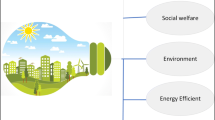Abstract
In the modern world, the Wi-Fi technology is undoubtedly one of the leaders in the field of wireless communications. Increasing density of devices in Wi-Fi networks and increasing number of the networks themselves have led to high interference and, as a result, to a decrease in the performance of Wi-Fi networks. One effective solution to reduce interference in dense deployment scenarios is the use of cloud-based management systems. In this work, we present an algorithm for centralized Wi-Fi network management for such a cloud-based system. The algorithm aims to maximize energy efficiency by solving an optimization problem with constraints where it is necessary to maximize the difference between two monotonic functions. Validation and evaluation of the effectiveness of the developed algorithm has been carried out in the NS-3 simulation environment.
Similar content being viewed by others
References
Barnett, T., Jain, S., Andra, U., and Khurana, T., Cisco Visual Networking Index (VNI), Complete Forecast Update, 2017–2022, Americas/EMEAR Cisco Knowledge Network (CKN) Presentation, December, 2018.
Khorov, E., Kiryanov, A., Lyakhov, A., and Bianchi, G., A Tutorial on IEEE 802.11ax High Efficiency WLANs, IEEE Commun. Surv. Tutorials, 2019, vol. 21, no. 1, pp. 197–216.
Khorov, E., Ivanov, A., Lyakhov, A., and Akyildiz, I.F., Cloud Control to Optimize Real-Time Video Transmission in Dense IEEE 802.11aa/ax Networks, Proc. IEEE 15th Int. Conf. on Mobile Ad Hoc and Sensor Systems (MASS), 2018.
Buzzi, S., Chih-Lin, I., Klein, T.E., Poor, H.V., Yang, C., and Zappone, A., A Survey of Energy-Efficient Techniques for 5G Networks and Challenges Ahead, IEEE J-SAC, 2016, vol. 34, no. 4, pp. 697–709.
Zorzi, M. and Rao, R.R., Energy-Constrained Error Control for Wireless Channels, IEEE Pers. Comm. Mag., 1997, vol. 4, no. 6, pp. 27–33.
Li, G.Y., Xu, Z., Xiong, C., Yang, C., Zhang, S., Chen, Y., and Xu, S., Energy-Efficient Wireless Communications: Tutorial, Survey, and Open Issues, IEEE Wirel. Commun., 2011, vol. 18, no. 6, pp. 28–35.
Miao, G., Himayat, N., Li, Y.G., Koc, A.T., and Talwar, S., Interference-Aware Energy-Efficient Power Optimization, Proc. 2009 IEEE ICC, 2009, pp. 1–5.
Venturino, L., Zappone, A., Risi, C., and Buzzi, S., Energy-Efficient Scheduling and Power Allocation in Downlink Ofdma Networks with Base Station Coordination, IEEE T. Wirel. Commun., 2015, vol. 14, no. 1, pp. 1–14.
Zappone, A. and Jorswieck, E., Energy Efficiency in Wireless Networks via Fractional Programming Theory, Found. Trends Commun. Inform. Theory, 2015, vol. 11, no. 3–4, pp. 185–396.
Tuy, H., Convex Analysis and Global Optimization, Germany, Springer, 2016.
Zappone, A., Bjornson, E., Sanguinetti, L., and Jorswieck, E., Globally Optimal Energy-Efficient Power Control and Receiver Design in Wireless Networks, IEEE T. Signal Process., 2017, vol. 65, no. 11, pp. 2844–2859.
Kiryanov, A.G., Krotov, A.V., Lyakhov, A.I., and Khorov, E.M., Algorithm for Dynamic Power Control and Transmission Scheduling in Infrastructural IEEE 802.11 ax Networks, Inform. Protsessy, 2019, vol. 19, no. 1, pp. 16–32.
Stefanyuk, V.L. and Tsetlin, M.L., On Power Control in a Collection of Radio Stations, Probl. Peredachi Inf., 1967, vol. 3, no. 4, pp. 49–57.
Merlin, S., TGax Simulation Scenarios. https://mentor.ieee.org/802.11/dcn/14/11-14-0980-16-00axsimulation-scenarios.docx
The NS-3 Network Simulator. http://www.nsnam.org/
Acknowledgments
The research was done at IITP RAS and supported by the Russian Government (Contract no. 14.W03.31.0019).
Author information
Authors and Affiliations
Corresponding authors
Additional information
This paper was recommended for publication by A.I. Lyakhov, a member of the Editorial Board
Russian Text © The Author(s), 2020, published in Avtomatika i Telemekhanika, 2020, No. 1, pp. 117–133.
Rights and permissions
About this article
Cite this article
Kiryanov, A.G., Krotov, A.V., Khorov, E.M. et al. Enhancing the Energy Efficiency of Dense Wi-Fi Networks Using Cloud Technologies. Autom Remote Control 81, 94–106 (2020). https://doi.org/10.1134/S0005117920010087
Received:
Revised:
Accepted:
Published:
Issue Date:
DOI: https://doi.org/10.1134/S0005117920010087




